
The Longshanculture, also sometimes referred to as the Black Pottery Culture, was a late Neolithic culture in the middle and lower Yellow River valley areas of northern China from about 3000 to 1900 BC. The first archaeological find of this culture took place at the Chengziya Archaeological Site in 1928, with the first excavations in 1930 and 1931. The culture is named after the nearby modern town of Longshan in Zhangqiu, Shandong. The culture was noted for its highly polished black pottery. The population expanded dramatically during the 3rd millennium BC, with many settlements having rammed earth walls. It decreased in most areas around 2000 BC until the central area evolved into the Bronze Age Erlitou culture. The Longshan culture has been linked to the early Sinitic . According to the area and cultural type, the Longshan culture can be divided into two types: Shandong Longshan and Henan Longshan. Among them, Shandong Longshan Cultural Site includes Chengziya Site; Henan Longshan Cultural Site includes Dengfeng Wangchenggang Site in Wangwan, Taosi Site and Mengzhuang Site in Hougang.
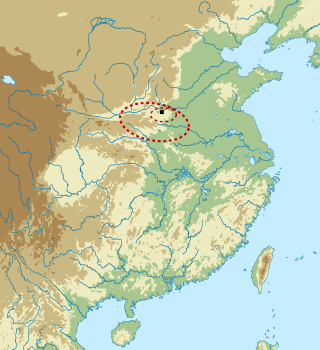

The Qijia culture was an early Bronze Age culture distributed around the upper Yellow River region of Gansu and eastern Qinghai, China. It is regarded as one of the earliest bronze cultures in China.
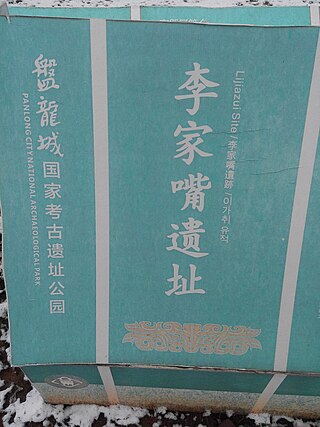
Panlongcheng or Panlong City is an archaeological site associated with the Erligang culture during the Shang dynasty period. The site is located just north of the Yangtze river, on the bank of the Panlong lake, and is surrounded by the Fushui river in Huangpi, Wuhan, Hubei, China. Panlongcheng is the largest excavated Erligang site, showing the southernmost reach of the Erligang culture at its peak. It was discovered in 1954, and excavated in 1974 and 1976.
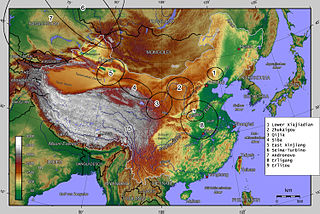
The Lower Xiajiadian culture is an archaeological culture in Northeast China, found mainly in southeastern Inner Mongolia, northern Hebei, and western Liaoning, China. Subsistence was based on millet farming supplemented with animal husbandry and hunting. Archaeological sites have yielded the remains of pigs, dogs, sheep, and cattle. The culture built permanent settlements and achieved relatively high population densities. The population levels reached by the Lower Xiajiadian culture in the Chifeng region would not be matched until the Liao Dynasty. The culture was preceded by the Hongshan culture, through the transitional Xiaoheyan culture. The type site is represented by the lower layer at Xiajiadian in Chifeng, Inner Mongolia.

The Upper Xiajiadian culture was a Bronze Age archaeological culture in Northeast China derived from the Eurasian steppe bronze tradition. It is associated with the Donghu of Chinese history.

Metallurgy in China has a long history, with the earliest metal objects in China dating back to around 3,000 BCE. The majority of early metal items found in China come from the North-Western Region. China was the earliest civilization to use the blast furnace and produce cast iron.

The Ordos culture was a material culture occupying a region centered on the Ordos Loop during the Bronze and early Iron Age from c. 800 BCE to 150 BCE. The Ordos culture is known for significant finds of Scythian art and may represent the easternmost extension of Indo-European Eurasian nomads, such as the Saka, or may be linkable to Palaeo-Siberians or Yeniseians. Under the Qin and Han dynasties, the area came under the control of contemporaneous Chinese states.
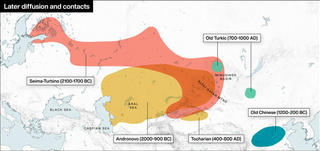
The Seima-Turbino culture, also Seima-Turbinsky culture or Seima-Turbino phenomenon, is a pattern of burial sites with similar bronze artifacts dated to c. 2300–1700 BCE found across northern Eurasia, particularly Siberia and Central Asia, maybe from Fennoscandia to Mongolia, Northeast China, Russian Far East, Korea, and Japan. The homeland is considered to be the Altai Mountains. These findings have suggested a common point of cultural origin, possession of advanced metal working technology, and unexplained rapid migration. The buried were nomadic warriors and metal-workers, traveling on horseback or two-wheeled carts.
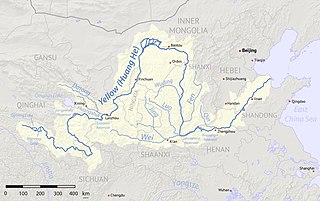
The Ordos Plateau, also known as the Ordos Basin or simply the Ordos, is a highland sedimentary basin in parts of most Northern China with an elevation of 1,000–1,600 m (3,300–5,200 ft), and consisting mostly of land enclosed by the Ordos Loop, a large northerly rectangular bend of the Yellow River. It is China's second largest sedimentary basin with a total area of 370,000 km2 (140,000 sq mi), and includes territories from five provinces, namely Shaanxi, Gansu, Ningxia, Inner Mongolia and a thin fringe of Shanxi, but is demographically dominated by the former three, hence is also called the Shaan-Gan-Ning Basin. The basin is bounded in the east by the Lüliang Mountains, north by the Yin Mountains, west by the Helan Mountains, and south by the Huanglong Mountains, Meridian Ridge and Liupan Mountains.

The Xianyun was an ancient nomadic tribe that invaded the Zhou dynasty. This Chinese exonym is written with xian獫 or 玁 "long-snouted dog", and this "dog" radical 犭 is commonly used in graphic pejorative characters. "Xianyun" was the preferred designation for northern tribes during the Zhou dynasty, earlier designations being the Xunyu, Guifang, and later ones being the Xiongnu, during the Han dynasty.

Guifang was an ancient ethnonym for a northern people that fought against the Shang Dynasty. Chinese historical tradition used various names, at different periods, for northern tribes such as Guifang, Rong, Di, Xunyu, Xianyun, or Xiongnu peoples. This Chinese exonym combines gui and fang, a suffix referring to "non-Shang or enemy countries that existed in and beyond the borders of the Shang polity."
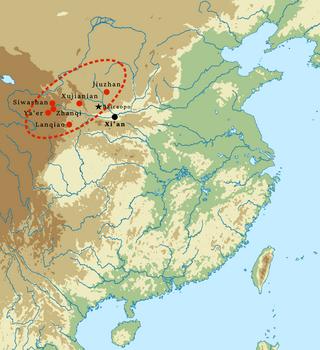
The Siwa culture was a Bronze Age culture in southeast Gansu Province, China. It was discovered by Swedish geologist Johan Gunnar Andersson in 1924 at Mount Siwa (寺洼山) in Lintao County, hence its name. It flourished circa 14th to 11th century BC, it is tentatively attributed to the cultures of the Northern Di, Qiang, and Xunyu peoples.

Xindian culture was a Bronze Age culture in the Gansu and Qinghai provinces of China. Xindian culture is dated ca. 1500–1000 BCE, a radiocarbon testing of an artefact produced a date around 1000 BCE, which roughly corresponds to the Western Zhou period of the Central Plain area.
Chaodaogou culture was a late Bronze Age nomadic archeological culture in the northern Hebei, Shanxi, Shaanxi, and Henan provinces of China, its center is located between the bend of the river Hunahe and the drainage basin of the Liao 遼/辽 river. Chaodaogou culture is cautiously dated to c. the 9th to 8th centuries BCE, falling within Western Zhou period of the Central Plain (Zhongyuan) area. The type site of the culture is Chaodaogou in Qinglong county, Hebei, excavated in May 1961. Another typical site of this culture is a cemetery in Linzheyu (林遮峪) in Baode county, Shaanxi. The Chaodaogou culture is roughly contemporary with the fishing and hunting nomadic Baijinbao culture in Heilongjiang.
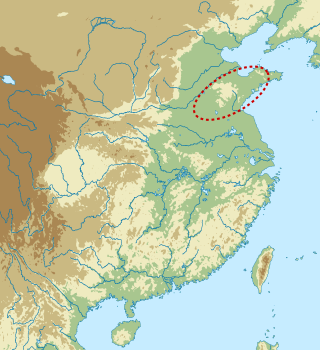
The Yueshi culture was an archaeological culture in the Shandong region of eastern China, dated from 1900 to 1500 BC. It spanned the period from the Late Neolithic to the early Bronze Age. In the Shandong area, it followed the Longshan culture period and was later replaced by the Erligang culture.
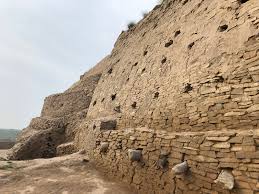
Shimao is a Neolithic site in Shenmu County, Shaanxi, China. It is closely associated to the Zhukaigou culture to the north. The site is located in the northern part of the Loess Plateau, on the southern edge of the Ordos Desert. It is dated to around 2000 BC, near the end of the Longshan period, and is the largest known walled site of that period in China, at 400 ha. The fortifications of Shimao were originally believed to be a section of the Great Wall of China, but the discovery of jade pieces prompted an archaeological investigation, which revealed that the site was of Neolithic age.

In 2001, the Institute of Archaeology of the Chinese Academy of Social Sciences organized a poll for China's 100 major archaeological discoveries in the 20th century. The participants included eight national-level institutions for archaeology and cultural relics, provincial-level archaeological institutes from 28 provinces, municipalities, and autonomous regions, as well as from Hong Kong, the archaeological departments of 11 major national universities, and many other scholars in Beijing. After three months and three rounds of voting, the results were announced on 29 March 2001 and were published in the journal Kaogu (Archaeology). In 2002, the Chinese Academy of Social Sciences Press published the book China's 100 Major Archaeological Discoveries in the 20th Century (二十世纪中国百项考古大发现), with more than 500 pages and 1,512 pictures.
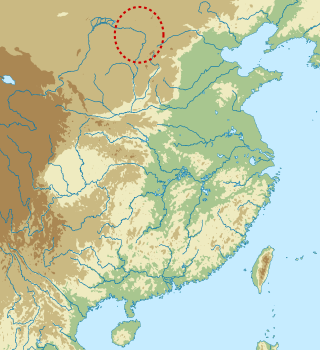
The Xicha culture, also Xicha-Lijiaya culture was a culture of Inner Mongolia and Greater Ordos area, from 1300 BCE to 1000 BCE. It succeeded the Zhukaigou culture, and preceded the Bronze Age Ordos culture.





















